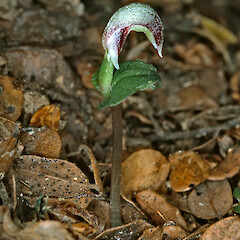Corybas cheesemanii
Common name
helmet orchid, Cheeseman’s spider orchid
Synonyms
Corysanthes cheesemanii Hook.f.
Family
Orchidaceae
Flora category
Vascular – Native
Endemic taxon
Yes
Endemic genus
No
Endemic family
No
Structural class
Orchids
NVS code
The National Vegetation Survey (NVS) Databank is a physical archive and electronic databank containing records of over 94,000 vegetation survey plots - including data from over 19,000 permanent plots. NVS maintains a standard set of species code abbreviations that correspond to standard scientific plant names from the Ngä Tipu o Aotearoa - New Zealand Plants database.
CORCHE
Chromosome number
2n = 54+2
Current conservation status
The conservation status of all known New Zealand vascular plant taxa at the rank of species and below were reassessed in 2017 using the New Zealand Threat Classification System (NZTCS) – more information about this can be found on the NZTCS website. This report includes a statistical summary and brief notes on changes since 2012 and replaces all previous NZTCS lists for vascular plants.
Please note, threat classifications are often suggested by authors when publications fall between NZTCS assessment periods – an interim threat classification status has not been assessed by the NZTCS panel.
- Conservation status of New Zealand indigenous vascular plants, 2017 . 2018. Peter J. de Lange, Jeremy R. Rolfe, John W. Barkla, Shannel P. Courtney, Paul D. Champion, Leon R. Perrie, Sarah M. Beadel, Kerry A. Ford, Ilse Breitwieser, Ines Schönberger, Rowan Hindmarsh-Walls, Peter B. Heenan and Kate Ladley. Department of Conservation. Source: NZTCS and licensed by DOC for reuse under the Creative Commons Attribution 4.0 International licence.
2017 | Not Threatened
Previous conservation statuses
2012 | Not Threatened
2009 | Not Threatened
2004 | Not Threatened
Distribution
Endemic. New Zealand: Manawatāwhi / Three Kings Islands, North Island, South Island, Chatham Islands.
Habitat
Coastal to montane ( up to 1000 m a.s.l.). Usually found in tall scrub or forest, in dark shaded sites, partially buried in deep, moist, semi-rotted leaf litter, especially under kānuka (Kunzea ericoides, K. robusta, K. serotina and K. triregensis) and beech (Fuscospora and Lophozonia spp.). Often associated with Corybas cryptanthus.
Detailed description
Diminutive, winter to spring green perennial herb up to 25 mm tall when flowering, up to 220 mm tall when fruiting. Stem, leaves usually, and sometimes also the flowers completely or partially buried within leaf litter. Tubers spheroidal to ovoid, borne on greatly elongated lateral roots up to 200 mm away from current seasons plant. Stem erect buried within leaf mould. Leaf solitary, sessile, 10–20 mm long, pale green to green above, somewhat silvery-green below, orbicular, orbicular-cordate, sometimes leaf reduced to a small green scale. Floral bract smaller than the bright yellow-green ovary, and usually placed well below it. Flower 1–(2), placed directly over leaf. Ovary erect. Perianth 10–14 mm tall. Dorsal sepal helmet-like (galeate), arching completely over labellum, acute, dark pink, purple-grey, maroon, greyish white (mushroom grey) greyish-white flecked with purple, or completely white, fleshy. Lateral sepals subulate (needle-like), minute, usually obscured by dorsal sepal, visible only from the front between the spurs. Petals much smaller than sepals, usually not discernible. Labellum cream or white, forming a curved tube, with the anterior margin sharply and abruptly deflexed under the tip of the galea, as a semicircular papillose lobe; the lobe hiding a median pouch; at the base on either side of the labellum a narrow conical spur projects downwards between the petals and sepals. Fruiting capsule up to 20 mm long, cylindrical to ovoid, erect to suberect, borne on a greatly elongated stem.
Manaaki Whenua Online Interactive Key
Similar taxa
When in flower this species could not be confused with any other indigenous orchid. The small leaf, and autumn to winter flowering habit are distinctive features, as is this species penchant for growing in deep drifts of leaf litter, usually in dark, very shaded sites. Fruiting material can be confused with Corybas cryptanthus with which it often grows. However, C. cryptanthus lacks leaves and chlorophyll, and the narrowly cylindrical capsule is 20–30 mm long, purple-flecked and as it is emerges it is bent toward the peduncle (stem), and often matures in a horizontal, rather than erect position.
Flowering
May–September
Flower colours
Red/Pink, Violet/Purple
Fruiting
November–January
Propagation technique
Difficult—should not be removed from the wild.
Etymology
corybas: Helmet flower
cheesemanii: Named after Thomas Frederick Cheeseman (1846 - 15 October 1923) who was a New Zealand botanist and naturalist who, in 1906, produced The Manual of the New Zealand Flora.
TAXONOMIC NOTES
Considerable research is underway to investigate the validity of the segregate genera split from Corybas R.Br. by Jones et al. (2002). Whilst much of that work has yet to be published, on advice from Australian Orchidologists Peter Weston and Stephen Hopper (pers. comm., July 2011, November 2014), all of the segregate genera recognised for New Zealand by Jones et al. (2002) are returned to Corybas (see also Lyons 2014; Lehnebach 2016).
Attribution
Fact Sheet prepared for NZPCN by P.J. de Lange 14 April 2007: Description adapted from Moore and Edgar (1970).
References and further reading
Jones DL, Clements MA, Sharma IK, Mackenzie AM, Molloy BPJ. 2002. Nomenclatural notes arising from studies into the Tribe Diurideae (Orchidaceae). The Orchadian 13(10): 437–468. https://www.biodiversitylibrary.org/item/310769#page/2/mode/1up.
Lehnebach C. 2016. New combinations and a replacement name for three New Zealand spider orchids (Corybas). The New Zealand Native Orchid Journal 139. 4–5.
Lyon SP. 2014. Molecular systematics, biogeography, and mycorrhizal associations in the Acianthinae (Orchidaceae), with a focus on the genus Corybas. PhD Thesis, University of Wisconsin-Madison, USA. https://asset.library.wisc.edu/1711.dl/UAXO3VHO6P7EH8Y/R/file-19145.pdf.
Moore LB, Edgar E. 1970. Flora of New Zealand, Volume II. Indigenous Tracheophyta: Monocotyledones except Gramineae. Government Printer, Wellington, NZ. 354 p.
NZPCN Fact Sheet citation
Please cite as: de Lange, P.J. (Year at time of access): Corybas cheesemanii Fact Sheet (content continuously updated). New Zealand Plant Conservation Network. https://www.nzpcn.org.nz/flora/species/corybas-cheesemanii/ (Date website was queried)











